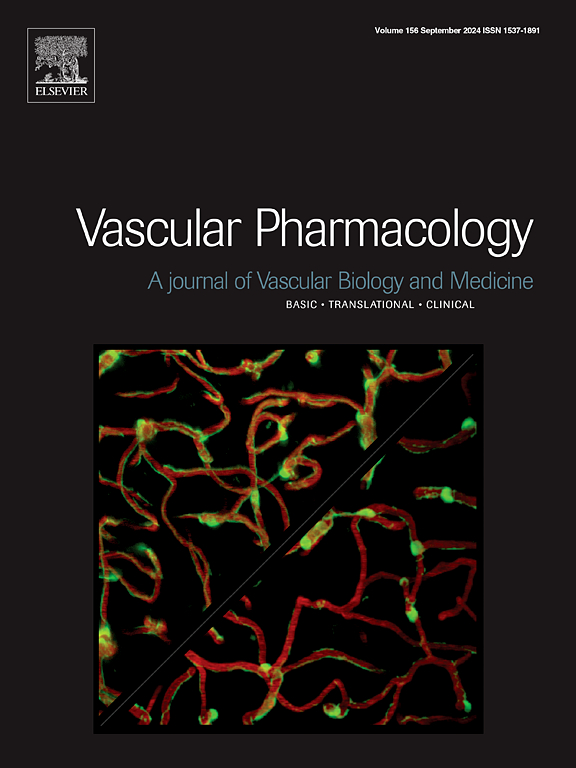Efficacy of beta-blocker agents on clinical outcomes in patients with thoracic aortic aneurysm: A systematic review and meta-analysis of randomized controlled trials
IF 3.5
3区 医学
Q2 PHARMACOLOGY & PHARMACY
引用次数: 0
Abstract
Objective
Studies investigating the efficacy of β-blocker agents for patients with thoracic aortic aneurysm (TAA) have produced heterogeneous and conflicting results. We assess the effects of β-blockers on clinical outcomes in patients with TAA.
Methods
A systematic literature search was performed through Ovid MEDLINE, EMBASE, Web of Science, Pubmed and Cochrane CENTRAL, all from inception to April 30, 2024. Randomized controlled trials (RCTs) exploring the effect of β-blocker agents in patients with TAA were considered for inclusion, with no population restriction. Inverse variance–weighted random-effects model was used. The overall risk of bias assessment was conducted by Cochrane Risk of Bias 2 tool. The primary outcome was aortic events during follow-up.
Results
We included a total of 161 patients with TAA (mean age, 27.6 years; 80 [49.7 %] male, mean follow-up 6.7 years) in 4 RCTs. The pooled risk ratio in the β-blocker arm for aortic events was 0.74 [95 % CI (0.20; 2.71), I2: 0 %, p = 0.64, low certainty of evidence (CoE)] when compared to placebo or no treatment in patients with TAA. The pooled risk ratios for aortic dissection or death (all-cause mortality) or in the β-blocker arm were 0.45 (95 % CI (0.10; 1.98), I2: 0 %, p = 0.29, low CoE) and 0.58 (95 % CI (0.15; 2.24), I2: 0 %, p = 0.43, low CoE), respectively. The risks of aortic dissection, rupture, or death were comparable, regardless of agent, disease, and age.
Conclusion
We found no evidence of benefit from β-blocker treatment for patients with TAA. More robust RCTs are needed to establish evidence-based recommendations.

β-受体阻滞剂对胸主动脉瘤患者临床疗效的影响:随机对照试验的系统回顾和荟萃分析
目的研究β-受体阻滞剂对胸主动脉瘤(TAA)患者的疗效产生了不同的和相互矛盾的结果。我们评估β受体阻滞剂对TAA患者临床预后的影响。方法通过Ovid MEDLINE、EMBASE、Web of Science、Pubmed和Cochrane CENTRAL进行系统的文献检索,检索时间为建站至2024年4月30日。研究β受体阻滞剂在TAA患者中的作用的随机对照试验(rct)被纳入考虑,没有人群限制。采用逆方差加权随机效应模型。总体偏倚风险评估采用Cochrane risk of bias 2工具。主要结局是随访期间的主动脉事件。结果共纳入161例TAA患者(平均年龄27.6岁;80例(49.7%)男性,平均随访6.7年。β受体阻滞剂组主动脉事件的合并风险比为0.74 [95% CI (0.20;2.71), I2: 0%, p = 0.64,低证据确定性(CoE)],与安慰剂或未治疗的TAA患者相比。主动脉夹层或死亡(全因死亡率)或β受体阻滞剂组的合并风险比为0.45 (95% CI (0.10;1.98), I2: 0%, p = 0.29,低CoE)和0.58(95%可信区间(0.15;2.24), I2: 0%, p = 0.43,分别低CoE)。与药物、疾病和年龄无关,主动脉夹层、破裂或死亡的风险具有可比性。结论我们没有发现β受体阻滞剂治疗TAA患者获益的证据。需要更有力的随机对照试验来建立基于证据的建议。
本文章由计算机程序翻译,如有差异,请以英文原文为准。
求助全文
约1分钟内获得全文
求助全文
来源期刊

Vascular pharmacology
医学-药学
CiteScore
6.60
自引率
2.50%
发文量
153
审稿时长
31 days
期刊介绍:
Vascular Pharmacology publishes papers, which contains results of all aspects of biology and pharmacology of the vascular system.
Papers are encouraged in basic, translational and clinical aspects of Vascular Biology and Pharmacology, utilizing approaches ranging from molecular biology to integrative physiology. All papers are in English.
The Journal publishes review articles which include vascular aspects of thrombosis, inflammation, cell signalling, atherosclerosis, and lipid metabolism.
 求助内容:
求助内容: 应助结果提醒方式:
应助结果提醒方式:


